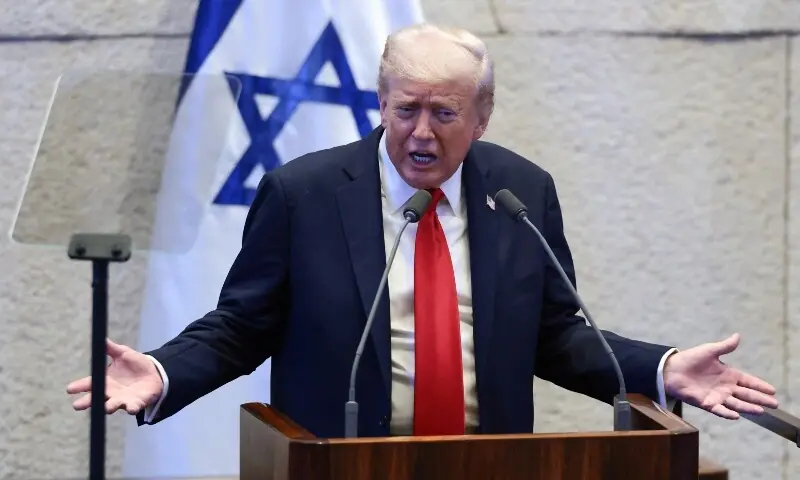Hope and celebration filled Israel as President Donald Trump arrived in Jerusalem, marking what he called “the golden age of Israel and the Middle East.”
His visit to the Israeli parliament, the Knesset, came just over two years after Hamas militants launched a brutal invasion that plunged the region into war.
Now, with the release of hostages and prisoners and a ceasefire finally in place, Trump stood before lawmakers declaring, “This is not only the end of a war—it’s the beginning of an age of faith, hope, and God.”
The Dawn of a Fragile Peace
Early that Monday morning, twenty Israeli hostages were freed after spending two harrowing years in captivity.
In exchange, Israel released hundreds of Palestinian prisoners, with more than 1,900 expected to regain their freedom in total.
For the first time since the war began, Hamas no longer held any Israeli captives.
The Knesset erupted in cheers as Trump took the podium, receiving a nearly three-minute standing ovation.
Lawmakers chanted his name—“Trump! Trump! Trump!”—as his daughter Ivanka, son-in-law Jared Kushner, and Secretary of State Marco Rubio looked on.
Kushner and Trump’s special envoy, Steve Witkoff, were both credited for their central roles in negotiating the peace deal that made this moment possible.
Tensions Beneath the Celebration
Despite the jubilation, questions about the durability of the ceasefire surfaced almost immediately.
A senior Hamas official told AFP that disarmament was “out of the question,” signaling that Hamas had no intention of surrendering its weapons.
Israeli Prime Minister Benjamin Netanyahu, while standing beside Trump, emphasized that the truce was only temporary.
Israel, he said, reserved the right to resume military operations if Hamas violated any terms of the agreement.
During his speech, Trump praised Netanyahu as a “patriotic leader,” admitting he wasn’t always easy to work with but lauding his strength during years of conflict.
The speech was briefly interrupted when a Knesset member began shouting in protest, but Trump diffused the moment with humor, quipping about Israel’s “efficient security.”
A Hero’s Welcome and Historic Praise
Knesset Speaker Amir Ohana introduced Trump with an extraordinary tribute, calling him a “colossus” and comparing him to Cyrus the Great—the Persian ruler who freed Jewish captives in 538 BC.
Ohana even announced plans to nominate Trump for the Nobel Peace Prize, saying that “thousands of years from now, the Jewish people will remember you.”
Trump became only the fourth U.S. president to address Israel’s parliament, joining the ranks of Jimmy Carter, Bill Clinton, and George W. Bush.
Spectators in the gallery wore red MAGA-style caps emblazoned with the words “Trump the Peace President.”
The Human Toll and the Road Ahead
The cost of this new beginning has been staggering.
According to Gaza’s Health Ministry, nearly 67,800 Palestinians were killed and more than 170,000 wounded during the two-year war.
Standing beside Netanyahu, Trump confirmed to reporters that the war was “over,” a statement expected to be formalized at a peace summit in Sharm el-Sheikh, Egypt.
The summit will bring together world leaders from across the Middle East and beyond—including representatives from Saudi Arabia, Egypt, Qatar, Jordan, Turkey, and Indonesia, as well as European and North American heads of state.
Netanyahu, though invited, declined to attend, citing an upcoming holiday.
Gratitude Across Israel
In Tel Aviv, thousands gathered in “Hostages Square” to celebrate the release of the 20 survivors.
Families wept, sang, and waved flags as the Red Cross transported the freed hostages from Gaza.
When Trump’s image appeared on nearby screens, the crowd erupted in cheers.
CNN reported a massive installation along the beach spelling out “Thank You” and “Home,” stretching across three football fields in front of the U.S. Embassy.
The tribute featured a large blue-and-yellow outline of Trump’s profile—a symbol of gratitude from many Israelis who saw him as instrumental in ending the bloodshed.
Looking Toward the Future
Before boarding Air Force One, Trump described the moment as “an honor and a privilege,” adding that rebuilding Gaza would begin immediately, though he admitted it would take time.
He spoke of establishing a “Board of Peace” to oversee Gaza’s reconstruction, hinting that former British Prime Minister Tony Blair might play a role.
Reflecting on his partnership with Netanyahu, Trump acknowledged they had “some disputes” but insisted they had always been quickly resolved.
He praised the prime minister as “the right man at the right time.”
Trump even expressed a personal wish: “I’d like to put my feet on Gaza, at least once.”
A Step Into the Unknown
As celebrations swept through Israel, Netanyahu described the moment as “the beginning of a new path,” assuring the families of remaining hostages that their freedom was now closer than ever.
“Together we will continue to win,” he said, “and with the help of God, we will guarantee the eternity of the land of Israel.”
The peace agreement, fragile yet full of promise, has sparked new hope for a region long scarred by division and loss.
Whether this marks the true start of a “golden age” or just another brief pause in a turbulent history remains to be seen—but for now, Israel and Gaza are breathing, at last, in the calm after the storm.
Share on Facebook «||» Share on Twitter «||» Share on Reddit «||» Share on LinkedIn